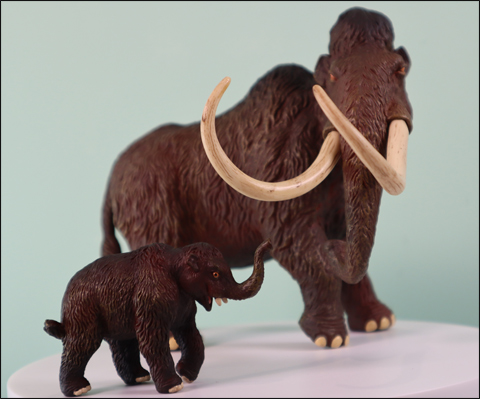Russian Scientists Begin Study of Mammoth Remains
“Mammoth of the Century” in Moscow for Study
The fossilised remains of a teenage Woolly Mammoth (Mammuthus primigenius) has begun to be examined by Moscow-based scientists after it was transported from the remote Siberian location where the fossilised carcase was discovered. The late Summer months of August and early September are when a number of Woolly Mammoth and other Ice Age fossils are found in the northernmost parts of Russia. The spring and summer rains coupled with the seasonally high temperatures permit parts of the permafrost to be thawed out or washed away by the erosion of river banks and this can expose the preserved remains of a number of long-dead prehistoric animals.
Woolly Mammoth Fossil
Some of the Woolly Mammoths have soft tissue preserved and with the publishing of the recent, controversial research into the half-life of DNA, talk inevitably turns to the possibility of obtaining genetic material from these extinct animals with the long-term aim of producing clones and resurrecting a species.
The Mammuthus genus (Mammoths) were members of the Elephantidae sub-family, taxonomically classified with extant elephants. They were highly successful herbivores that lived across northern latitudes (Asia, Europe and North America) as well as Africa. A number of species have been identified including the famous Woolly Mammoth (M. primigenius) and the larger species, associated with milder climates, the Columbian Mammoth (M. columbi).
The latest Woolly Mammoth fossil to emerge from the permafrost of northern Siberia was found by a young boy called Yevgeny Salinder, whilst he was walking along the banks of the Yenisei river about six weeks ago. Mammoth fossils including tusks had been found in this area before, but it was not the sight of an over-sized, curved tusk that indicated to Yevgeny that he had found the remains of a Woolly Mammoth, but rather the smell the carcase gave off. As the long-dead animal’s corpse is exposed to the air with the erosion of the matrix in which the fossil was buried, so the flesh begins to decompose once again. It was the smell of putrefying flesh that alerted eleven-year old Yevgeny that a Mammoth’s body was lying nearby.
Models of Woolly Mammoths (CollectA Age of Dinosaurs Popular Models and Deluxe)

The CollectA Deluxe Woolly Mammoth model in 1:20 scale and the CollectA Prehistoric Life Woolly Mammoth calf. Picture credit: Everything Dinosaur.
Picture credit: Everything Dinosaur
To view models and figures of Woolly Mammoths and other extinct animals: CollectA Deluxe – Figures and Models (Prehistoric Animals).
Exposing the Carcase
The back quarters and the legs were the parts of the carcase first exposed, local officials were contacted and the International Mammoth Committee alerted so that an excavation could begin to remove the Woolly Mammoth. Scientists rushed out to the remote location and began the work of digging out the Mammoth remains. Alexei Tikhonov, of the St. Petersburg-based Zoological Museum, and an expert of Siberian Mammoths was one of the scientists dispatched to excavate the carcase. He has described this particular specimen as the best preserved and most complete Mammoth found in Russia for more than 100 years.
Nicknamed the “Mammoth of the Century”, the specimen is that of a teenage Woolly Mammoth, a male that died around 30,000 years ago. Although the elephant’s trunk has rotted away, scientists have found samples of fur intact and one 1.5 metre long tusk, along with the remains of an eye and a small, Mammoth ear. Mammoths had much smaller ear flaps than their modern elephant counterparts. Small ears would not have lost as much heat as a large ear flap and there was no need for large ears to help cool the animal down, temperatures in this part of the world during the Pleistocene Epoch when this animal lived, would have rarely climbed into double figures (Celsius).
With the aid of local volunteers the Mammoth fossil was carefully excavated out of its Siberian grave, the process taking more than a week to complete. Once the remains had been stabilised (kept at a constant, low temperature to preserve soft tissue), the fossil has been transported back to Moscow for detailed study. Parts of the specimen will also be examined by Russian palaeontologists in St. Petersburg.
Preserving an Ancient Elephant
Weighing over 1,000 kilogrammes; the carefully packed and preserved ancient elephant may provide researchers with Mammoth DNA. Viable genetic material could still be preserved deep in the large teeth of the animal or within the larger limb bones such as the femur. With a team of international scientists recently concluding that DNA might be able to survive for much longer than previously thought in the fossil record (based on evidence from New Zealand Moa fossils), there is a strong possibility that this 30,000 year old carcase might yield genetic material.
To read an article on the research into a DNA half-life: Research into the Half-life of DNA.
Russian scientists are keen to start work, although they will have to be properly protected and wear face masks to ensure exposure to ancient bacteria and other pathogens does not occur. They will also be keen to avoid any potential DNA contamination. The skeleton is virtually intact and the body cavity has not been punctured which may have permitted the gut and the other internal organs such as the heart to be preserved.
Like many Woolly Mammoth fossil finds, this teenage Mammoth that was probably around sixteen years of age when it died, has been given a name as well as a formal scientific classification code. The Mammoth has been named Zhenya, a pet name used by the friends and family of Yevgeny, the boy who sniffed out the fossil discovery in the first place.

